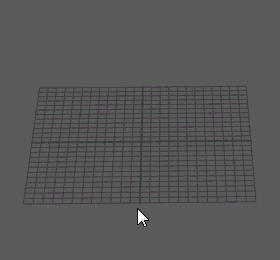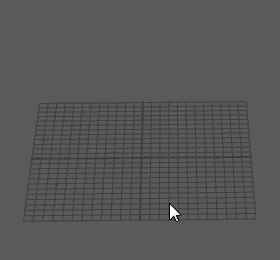Interactive polygon creation allows you to manually adjust the size of primitives during creation. It provides a level of visual feedback that menu or shelf creation cannot.
To create a polygon primitive interactively
- Turn on Create > Polygon Primitives > Interactive Creation.
- Select
Create > Polygon Primitives, and choose the primitive type, or select the primitive type from the
Polygons shelf.
Note: You can change non-interactive attributes such as Radius, Divisions, or Texture Mapping UVs via the option box (
 ). See
Polygon Primitives Options for more information.
). See
Polygon Primitives Options for more information.
- Create a primitive interactively using the appropriate method:
Primitive type Procedure Example Sphere, Torus, Pyramid, Soccer Ball, Platonic Solids
- In the scene view, click-drag to create the primitive.
Note: The Torus primitive has an additional click-drag step to specify the Section Radius attribute.

Cube, Cylinder, Cone, Prism
- In the scene view, click-drag to specify the location and base size.
- Click-drag again to specify the height.

Pipe, Helix
- In the scene view, click-drag to specify the location and base size.
- Click-drag to specify the height.
- Click-drag to specify the following attributes for these primitive types:
- Pipe - specifies the thickness of the pipe.
- Helix - specifies the number of coils.
 If you want to skip interactively setting an attribute during the creation process, click with your mouse to move to the next step.Note: You can more accurately set the axis for your primitive using the orthogonal views. Whichever view you create your primitive in—top, front, or side—is the way your primitive’s axis will be aligned (y, z, or x).
If you want to skip interactively setting an attribute during the creation process, click with your mouse to move to the next step.Note: You can more accurately set the axis for your primitive using the orthogonal views. Whichever view you create your primitive in—top, front, or side—is the way your primitive’s axis will be aligned (y, z, or x). - In the scene view, click-drag to create the primitive.
- (Optional) During the creation process, holding the Shift or Control keys to achieve the following effects:
- Ctrl: Grows plane and cube primitives from their center. (No effect on all other primitives.) When adjusting primitive attributes in subsequent interactive steps, pressing the Control key momentarily reduces the mouse speed.
- Shift: Constrains all primitives to three-dimensional equilateral proportions and grows them from their base. When adjusting primitive attributes in subsequent interactive steps, pressing the Shift key momentarily increases the mouse speed.
- Ctrl + Shift: Constrains all primitives to three-dimensional equilateral proportions and grows them from their center.
Additionally, pressing Enter at any point during the interactive creation process immediately completes the primitive creation and skips any remaining attributes.
- Once the primitive creation steps are complete, the wireframe color for the primitive changes from a bright green to the green color for an actively selected object.
Note: Primitives with caps (Pyramid,Cylinder, Cone, Pipe) have an additional attribute called Adjust cap subdivisions after create that is turned off by default. When you turn this feature on in the primitive’s tool options window, an additional step is added to the interactive creation process for those primitive types.
To create a polygon primitive with a single click
- Select
Create > Polygon Primitives > Interactive Creation. (Ensure that a check mark appears beside the
Interactive Creation menu item)
Note: You can change non-interactive attributes such as Radius, Divisions, or Texture Mapping UVs via the option box (
 ). See
Polygon Primitives Options for more information.
). See
Polygon Primitives Options for more information.
- Click in the scene view to create the primitive.
- Press T to activate the Show Manipulator Tool.
- In the In-View Editor that appears, adjust the poly<shape> node attributes.
To create multiple polygon primitives interactively
- Turn off
Create > Polygon Primitives > Exit on Completion.
You can now create multiple polygon primitives in succession without having to return to the Polygon Primitive menu or Shelf each time.
Useful Interactive Creation options
During interactive primitive creation, you can snap the polygon to existing objects in the scene. You can snap to the grid; curves; a CV, vertex, or pivot; live object.
These features let you snap to a projected point on the line or plane defined by any other object in your scene while you create the primitive. For example, you could create a cylinder to act as a telescope on the dome of an observatory.
Instead, create the base of a cube in the perspective view, then switch to a front or side orthographic view to snap the height of the cube using the grid as a reference.